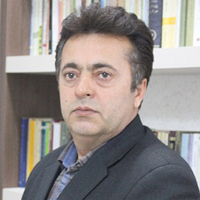Introduction and Analysis of the Architecture of the Tomb of Sultan Ibrahim Reza in Darmian City and Reading the Relics of its Historical Writings
Author(s):
Article Type:
Research/Original Article (دارای رتبه معتبر)
Abstract:
The study of Islamic Period buildings in Iran proves the presence of countless religious and non-religious tombs that are scattered in most parts of this border and region. As one of the most important elements of Islamic-Iranian architecture, these buildings have a special diversity, so that their study reveals the architectural and decorative features of each period. Tomb for religious Personalities in Iran has received more attention than other Islamic countries; the reason for this is the role of tombs and its integration with the customs and religion of Muslim Iranians, and this is the reason that justifies the continued popularity of religious tombs in Iran. In this research, the architecture of the tomb of Sultan Ibrahim Reza located in Abgarm village of Darmian city, South Khorasan province will be introduced. In the present article, while introducing and analyzing the architecture of the building, motifs and decorations, inscriptions and memorabilia of the building are discussed. The present article is based on a descriptive-analytical method and its findings are partly through the study of library resources and the other part is done in the field. The main question of the research is in what period this building was built and what are the salient features of the building architecture? According to the inscription of the building and short reports made by previous scholars, the construction date of the building dates back to the Safavid period, while by studying and analyzing the architecture of Timurid buildings in Khorasan, it probably dates back to the late Timurid period. The tomb of Sultan Ibrahim Reza is a two-storey building with four porches and a magnificent dome. Among the architectural features of the building are symmetry, the use of various arches and magnificent inscriptions on the body of the building, which provide complete information about this building over a long period of time.
Keywords:
Language:
Persian
Published:
Journal of Archaeological Studies, Volume:13 Issue: 4, 2022
Pages:
189 to 213
magiran.com/p2430241
دانلود و مطالعه متن این مقاله با یکی از روشهای زیر امکان پذیر است:
اشتراک شخصی
با عضویت و پرداخت آنلاین حق اشتراک یکساله به مبلغ 1,390,000ريال میتوانید 70 عنوان مطلب دانلود کنید!
اشتراک سازمانی
به کتابخانه دانشگاه یا محل کار خود پیشنهاد کنید تا اشتراک سازمانی این پایگاه را برای دسترسی نامحدود همه کاربران به متن مطالب تهیه نمایند!
توجه!
- حق عضویت دریافتی صرف حمایت از نشریات عضو و نگهداری، تکمیل و توسعه مگیران میشود.
- پرداخت حق اشتراک و دانلود مقالات اجازه بازنشر آن در سایر رسانههای چاپی و دیجیتال را به کاربر نمیدهد.
In order to view content subscription is required
Personal subscription
Subscribe magiran.com for 70 € euros via PayPal and download 70 articles during a year.
Organization subscription
Please contact us to subscribe your university or library for unlimited access!


